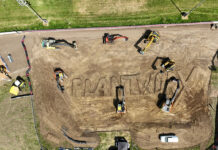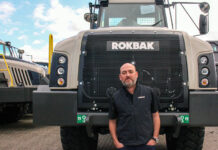
Andrew McBride, Peatland ACTION project manager explains why the Scottish Government is pledging £250 million for peatland restoration over the next 10 years, and what opportunities this presents for machinery operators and suppliers
WHETHER we know it or not, peatlands, like bogs and fens, play a crucial role in all of our lives. Covering vast areas of the country, peat is a soil made of slowly decaying plant material – mostly sphagnum mosses – formed in waterlogged conditions.
As stores of carbon, peatlands are important in tackling climate change but they also help with flood regulation, provide good water quality and support nationally and internationally important nature. They are a key part of our rural, farming and crofting communities.
Sadly, peatlands are also one of Scotland’s largest degraded ecosystems. At almost two million hectares, blanket bogs cover about 20% of Scotland’s land area. It is generally thought that around 80% of the UK’s peatlands are damaged in some way. Most of that peatland is in Scotland and it is estimated that 70% of Scotland’s blanket bog and 90% of Scotland’s raised bogs have been damaged to some degree.
Much of the damage relates to historic management, for example, drainage, inappropriate burning and overgrazing. In many cases even if this damage occurred many years ago, the effects persist for many years afterwards.
When peatlands are damaged, the peat decomposes and stored carbon is released as carbon dioxide (CO2) into the atmosphere, contributing to climate change. However, when restored, loss of carbon is significantly reduced. Restored peatlands capture and store new carbon through vegetation growth and the process of peat formation. Restoring peatlands is gaining increased recognition as a nature-based solution to mitigating climate change and as such offers many opportunities to landowners and contractors.
So what are we doing?
Peatland ACTION started in 2012, when the Scottish Government allocated funds to a Scottish Natural Heritage led peatland restoration project to kick-start the restoration challenge. Peatland ACTION continues to restore damaged peatlands in Scotland by providing advice and funding to landowners and land managers who want to restore their peatland habitats. This support is available from a project’s conception through to help with practical work.
To date over £30 million has been invested in Peatland ACTION, with the Scottish Government pledging a further £250 million over the next 10 years to restore 250,000 ha of damaged peatland by 2030.
Up to the end of March last year, through working with a wide range of land managers, 19,000 hectares were put on the road to recovery, covering over 200 sites across Scotland in the lowlands, uplands and islands. In 2018–2019 Peatland ACTION delivered 5,800 hectares and the project anticipates restoring a similar amount in 2019/20.
What does this mean for contractors?
With an estimated 600,000ha of degraded peat there is a massive amount of potential work for contractors, who are crucial for carrying out this work. The work is not always easy, but can be very rewarding for those who take the plunge into this expanding area of work. In the past contractors have enthusiastically responded through expansion of machine fleets and using innovations in both equipment and techniques to make the work more effective.
Working on peat often in remote locations requires the right kit and operators who are tuned into the way peatlands work. Operators often have to think creatively as the peat surface is highly variable and although we use around 25 different techniques to restore the peat, there are no specific standards for operators to follow.
Key considerations when working on peat:
• Operators: Critical to the whole operation, peatland restoration operators are a pretty self-reliant crew and need to be. Often working at least several miles up a track, they have to be well prepared and able to sort out minor machinery repairs. Also they are key decision makers as to the restoration techniques used and need an understanding of the peatland and its hazards to ensure getting stuck or bogging is a rare occurrence.
• Machines: A wide array of machines are used to carry out and support restoration work on sites. The most popular type of vehicles being used on restoration sites are 360 excavators, ranging between 7.5 and 14 tonnes. Mini diggers are not for bogs. The larger excavators usually have a higher output than smaller ones and enable larger sods of peat to be moved which improves the overall work quality. For some projects there can be benefits of using a mixed fleet of small and large excavators. For example, in gullied areas a small excavator has the flexibility to get into tight gullies, whilst a larger machine has the advantage in deep gullies with its greater reach.
• Number of machines: It is considered good practice to use two machines on project sites in case one machine starts to get stuck, the second machine can help winch it out. For large projects it can be feasible for smaller contracting companies to join forces to enable them to bid for a wider range of work.
• Tracks: The absolute minimum track width is 800mm, which is suitable for drier bogs, but 900mm or above provides a greater piece of mind for operators working on peat. Some contractors, particularly in the forest to bog sector, are now using 1,900mm tracks and extend the undercarriage.
• Buckets: A range of bucket sizes are used with a strong preference for wider buckets. A lot depends on the operator skill. Tilting buckets significantly increase output as the machine can stay in the same position for longer.
• Bog mats: When working on wetter more complex bogs, bog mats are kept on site as an insurance policy if bogging starts. In most cases they slow work rates substantially and most contractors prefer to invest in wider tracks.
• Access: Even in remote areas there are gates, rocks, bridges and fords all which can present problems when using wide tracked machines. Although not quite up to Formula 1 pit crew speed, many operators have become adept at changing tracks to get through tight spots. In other cases fences and gates are moveable.
• Access to machines: Often the restoration work can be up to 0.5km from the main access track, over wet bog. One-off access across these areas is easy. However daily tracking in ATVs to get operators to machines and to bring in fuel, often in the dark winter days, has its challenges and leads to breaking the vegetation surface and erosion. This is often dealt with by using temporary drainage, ensuring single direction tracking in on one route and out another, and moving the route as soon as there are signs of vegetation deterioration. Temporary plastic matting is also being trialled.
How to get involved with on-the-ground Peatland ACTION
Peatland Action offers technical restoration advice, training and demonstrations of restoration techniques for machine operators and companies who want to move into peatland restoration.
If you would like to be part of the ongoing work of Peatland ACTION please contact peatlandaction@nature.scot. Follow us @PeatlandACTION or visit us on the web: www.nature.scot/peatlandaction








